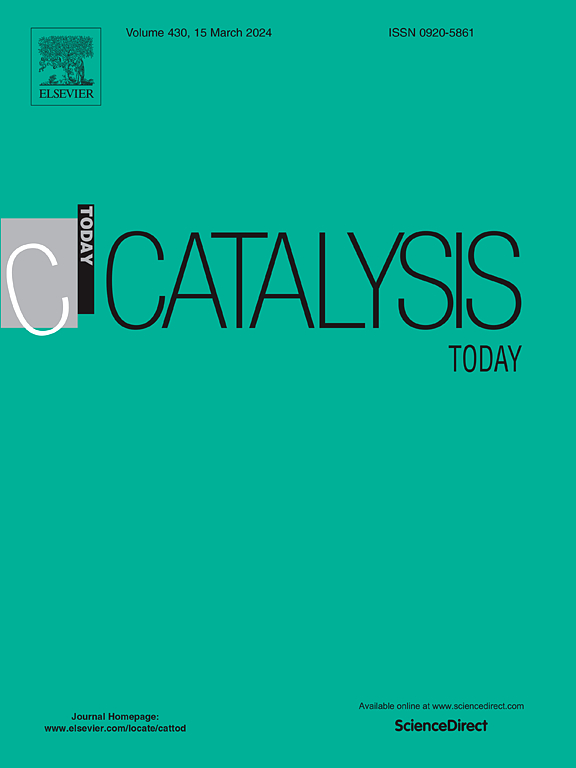H2 production from photocatalytic reforming of PET over Pt/TiO2: The role of terephthalic acid
IF 5.2
2区 化学
Q1 CHEMISTRY, APPLIED
引用次数: 0
Abstract
Photoreforming is a promising method for the conversion of waste materials with simultaneous production of H2. The use of waste polyethylene terephthalate (PET) as a photoreforming substrate has been previously investigated, however its insolubility in aqueous media and the resistance of the aromatic terephthalate towards conversion are major obstacles. Commonly an alkaline pretreatment step is used to initiate hydrolysis to ethylene glycol and terephthalic acid which promotes H2 evolution. However, in this work we have found that TPA has both promotional and inhibitory effects by modification of the catalyst surface that depend on the relative concentration of ethylene glycol. Terephthalic acid inhibits the oxidation reactions by scavenging hydroxyl radicals and blocking complexation sites. This leads to lower H2 evolution compared to the photoreforming of an equivalent concentration of ethylene glycol. Even in trace amounts, terephthalic acid would still inhibit the reaction unless the concentration of ethylene glycol was high enough. Surprisingly, at ethylene glycol concentrations of > 1.2 M, residual terephthalic acid promoted the reaction which is thought to be due to increasing the interaction between ethylene glycol and the catalyst surface but also an increased role of water. On the basis of these results, we suggest that, if PET is to be used as a feedstock for H2 generation by photoreforming, an initial hydrolysis should be performed after which terephthalic acid is separated for re-use. The remaining hydrolysate may then be used for photoreforming. Furthermore, the ethylene glycol concentration should be maximized in order to overcome the inhibitory effects of residual terephthalic acid.
Pt/TiO2催化PET光催化重整制氢:对苯二甲酸的作用
光重整是一种很有前途的废物转化和同时生产H2的方法。利用废弃的聚对苯二甲酸乙二醇酯(PET)作为光重整底物已经进行了研究,但是它在水介质中的不溶性和芳香族对苯二甲酸乙二醇酯对转化的抗性是主要障碍。通常采用碱性预处理步骤引发水解生成乙二醇和对苯二甲酸,从而促进H2的生成。然而,在这项工作中,我们发现TPA通过修饰催化剂表面具有促进和抑制作用,这取决于乙二醇的相对浓度。对苯二甲酸通过清除羟基自由基和阻断络合位点来抑制氧化反应。与同等浓度的乙二醇光重整相比,这导致了较低的氢气析出。即使是微量的对苯二甲酸也会抑制反应,除非乙二醇的浓度足够高。令人惊讶的是,当乙二醇浓度为>; 1.2 M时,残留的对苯二甲酸促进了反应,这被认为是由于乙二醇和催化剂表面之间的相互作用增加,但也增加了水的作用。基于这些结果,我们建议,如果要将PET用作光重整制氢的原料,则应进行初始水解,然后分离对苯二甲酸进行再利用。剩余的水解产物可用于光重整。此外,为了克服残留对苯二甲酸的抑制作用,应最大限度地提高乙二醇浓度。
本文章由计算机程序翻译,如有差异,请以英文原文为准。
求助全文
约1分钟内获得全文
求助全文
来源期刊

Catalysis Today
化学-工程:化工
CiteScore
11.50
自引率
3.80%
发文量
573
审稿时长
2.9 months
期刊介绍:
Catalysis Today focuses on the rapid publication of original invited papers devoted to currently important topics in catalysis and related subjects. The journal only publishes special issues (Proposing a Catalysis Today Special Issue), each of which is supervised by Guest Editors who recruit individual papers and oversee the peer review process. Catalysis Today offers researchers in the field of catalysis in-depth overviews of topical issues.
Both fundamental and applied aspects of catalysis are covered. Subjects such as catalysis of immobilized organometallic and biocatalytic systems are welcome. Subjects related to catalysis such as experimental techniques, adsorption, process technology, synthesis, in situ characterization, computational, theoretical modeling, imaging and others are included if there is a clear relationship to catalysis.
 求助内容:
求助内容: 应助结果提醒方式:
应助结果提醒方式:


